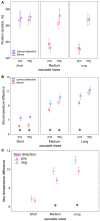Visual encoding and fixation target selection in free viewing: presaccadic brain potentials
- PMID: 23818877
- PMCID: PMC3694272
- DOI: 10.3389/fnsys.2013.00026
Visual encoding and fixation target selection in free viewing: presaccadic brain potentials
Abstract
In scrutinizing a scene, the eyes alternate between fixations and saccades. During a fixation, two component processes can be distinguished: visual encoding and selection of the next fixation target. We aimed to distinguish the neural correlates of these processes in the electrical brain activity prior to a saccade onset. Participants viewed color photographs of natural scenes, in preparation for a change detection task. Then, for each participant and each scene we computed an image heat map, with temperature representing the duration and density of fixations. The temperature difference between the start and end points of saccades was taken as a measure of the expected task-relevance of the information concentrated in specific regions of a scene. Visual encoding was evaluated according to whether subsequent change was correctly detected. Saccades with larger temperature difference were more likely to be followed by correct detection than ones with smaller temperature differences. The amplitude of presaccadic activity over anterior brain areas was larger for correct detection than for detection failure. This difference was observed for short "scrutinizing" but not for long "explorative" saccades, suggesting that presaccadic activity reflects top-down saccade guidance. Thus, successful encoding requires local scanning of scene regions which are expected to be task-relevant. Next, we evaluated fixation target selection. Saccades "moving up" in temperature were preceded by presaccadic activity of higher amplitude than those "moving down". This finding suggests that presaccadic activity reflects attention deployed to the following fixation location. Our findings illustrate how presaccadic activity can elucidate concurrent brain processes related to the immediate goal of planning the next saccade and the larger-scale goal of constructing a robust representation of the visual scene.
Keywords: EEG; attention; change detection; heat maps; presaccadic interval; saccade guidance; saccades; visual encoding.
Figures







References
-
- Becker W. (1991). Saccades, in Vision and Visual Dysfunction, ed Carpenter R. H. S. (Boca Raton, FL: CRC Press; ), 95–137
-
- Becker W., Hoehne O., Iwase K., Kornhuber H. H. (1973). Cerebral and ocular muscle potentials preceding voluntary eye movements in man. Electroencephalogr. Clin. Neurophysiol. Suppl. 33, 99–104 - PubMed
LinkOut - more resources
Full Text Sources
Other Literature Sources

